Salon des Refusés
From The Art and Popular Culture Encyclopedia

|
Related e |
|
Featured: |
The Salon des Refusés (Salon of the Rejected) was an art exhibition in Paris.
In the 1860s, artists of the nascent realist and impressionist movements submitted works to the Salon de Paris, the official exhibition sponsored by the Académie des beaux-arts, selection committee only to be rejected. The resultant complaints of bias led French emperor Napoleon III to allow the rejected works to be displayed in a separate exhibition.
The first Salon des Refusés on May 17 1863 invited art-works rejected for display at the Salon de Paris.
Most were poor quality, leading to ridicule in the press. However, the exhibition included several important paintings including Édouard Manet's Le déjeuner sur l'herbe (The Luncheon on the Grass) and James McNeill Whistler's The White Girl. Other artists who showed at the Salon des Refusés include Henri Fantin-Latour, Paul Cézanne, Armand Guillaumin, Johan Jongkind, and Camille Pissarro.
Salon des Refusés was held in 1874, 1875 and 1886. In 1881 the government withdrew official sponsorship, and a group of artists organised the Société des artistes français to take responsibility for the Salon de Paris.
By extension, salon des refusés may refer to any exhibition of works rejected from a juried art show.
See also

